|
C.J. Crane, Biography, 1942 (Source: Link)
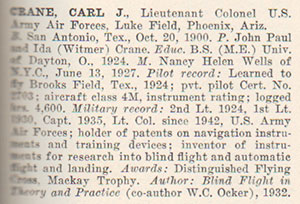 |
Carl J. Crane was born and raised a Texan. He was born in San Antonio on October 20, 1900. The 1910 U.S. Census, his first, placed him at age 9 living in San Antonio with his father, John P. (age 40), mother Ida (34) and his sister Ida (2). His father was employed as a "Grocer" for a "Wholesale Grocery."
The short biography, left, is from this 1942 REFERENCE, page 97. Note that he learned to fly in the army at Brooks Field, San Antonio, TX in 1924, and earned private pilot certificate 2703. Importantly, notice his later expertise with aerial navigation instrumentation.
The 1920 Census cited Crane living with his parents and sister in San Antonio. Curiously, his age was given as 29. It should have been 19; obviously a coding error. His occupation was listed as "Machinist" for an "Auto Company." Also in the household was a roomer, Charles Webber, age 28. His occupation was listed as a "District Manager" for the "City."
Crane stands among a few other Register pilots who changed the fundamentals of aviation science and made flight safer, easier and more broadly acceptable by civil, military and commercial operations. See also Albert Hegenberger, Jimmy Doolittle and R.W. Henderson. Crane was not only a military and civil pilot, but he was also an inventor. He designed, had built, and tested cockpit instruments that allowed aircraft to land themselves with minimum input from their pilots.
Available at findagrave.com is this biographical statement, below. The statement was written by the family of Crane's daughter based on information available at the Texas State Historical Association (TSHS). Note the feat described in the next to last paragraph.
Grandpa did not attend West Point, but he was an instructor there for a time, which is how and where he met his first wife Helen (Nancy) Wells. Marriage Date: July 11, 1925, In Manhattan, NY [note the discrepancy in wedding date in the 1942 biography, above].
Carl studied at St. Mary's University, San Antonio, and the University of Dayton (Ohio), where he received the bachelor (1924) and the master of mechanical engineering (1934) degrees. After graduating from the United States Army Advanced Flying School at Kelly Field in 1925, he spent two years with the First Pursuit Group at Selfridge Field in Michigan, and then for five years was a flight instructor at Kelly, Brooks, and Randolph fields in Texas. In 1929 he teamed with [Register pilot] William C. Ocker to devise revolutionary flying systems and to write the world's first manual for instrumental flight, Blind Flight in Theory and Practice (1932).
On August 23, 1937, at Wright-Patterson Air Force Base, Carl Crane made the world's first fully automated landing, for which he had designed the key instruments. He served in military aviation until 1949.
Crane was a member of the Daedalians and of the Institute of Navigation, a fellow of the American Institute of Aeronautics and Astronautics, and the holder of the Mackay Trophy, the Distinguished Flying Cross, and distinguished alumnus awards from both St. Mary's and the University of Dayton. In 1979 he received the Flight Safety Foundation's Pioneer Award.
|
Mackay Trophy Award, American Aviation, August 1, 1938 (Source: NASM)
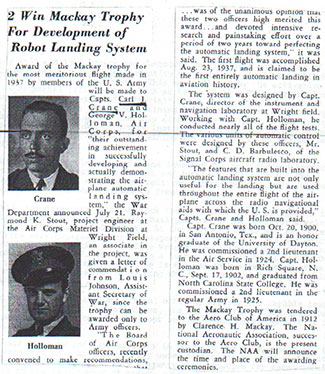 |
The TSHS link states, "On August 23, 1937, at Wright-Patterson Air Force Base, with assistance from [Register pilot] G. V. Holloman and Raymond Stout, Crane made the world's first fully automated landing, for which he had designed the key instruments."
And further, "Among his more than 100 patented inventions were radio signaling equipment for use in aircraft trainers, which was licensed for use in the Link Trainer; the Navitrainer, designed with Colonel Ocker; the B-3 Drift Meter [example of a Navy drift instrument at the link]; the Gyro Panoramic Sextant; and numerous other navigational devices. He had inventions on the drawing board and patents pending when he died [in 1982]." Crane's 1937 accomplishment was documented in Air & Space magazine, August, 2012, at the link. Ocker and Crane were awarded the Mackay Trophy for development of the automatic landing system. The award was documented in American Aviation, August 1, 1938, right.
"Autoland," as the technology was later termed, is now common on many transport aircraft. Why would anyone want to autoland an aircraft? Because under some circumstances of weather, like very low clouds and fog, a human pilot is generally unable to respond to the rapidly changing, last minute visual cues outside the aircraft when it is near enough to the ground to land. There are several categories of autoland, depending upon how limiting the meteorology is, and in how close the aircraft is allowed to get to the ground. There is a category that allows the airplane to land with zero visibility and with zero clearance from the ground. The pilots need not assist even the rollout and braking, which are also automatic. Wind is the primary limiter of category. Too much wind, and the airplane and crew are limited to a lower category, i.e. one that requires some lateral visibility and a ceiling.
For example, you can watch at the link an Airbus A320 autoland at Vienna, Austria in 2013. And at this link a Boeing 737 autolands at Geneva, Switzerland on Christmas Eve, 2013 (look for the crossing traffic in this film). And this film, of an instrument approach and landing at Queenstown, New Zealand. While not an autoland experience, this last video gives a good taste of what instrument flight is all about. If you're an instrument-rated pilot, you'll know the feeling. Enjoy the views straight ahead and don't forget to breathe. These examples are technical flying at its best.
Another invention by Crane, a ground simulator, was featured in Popular Aviation (PA) magazine, July, 1937, below.
Popular Aviation, July, 1937 (Source: PA)
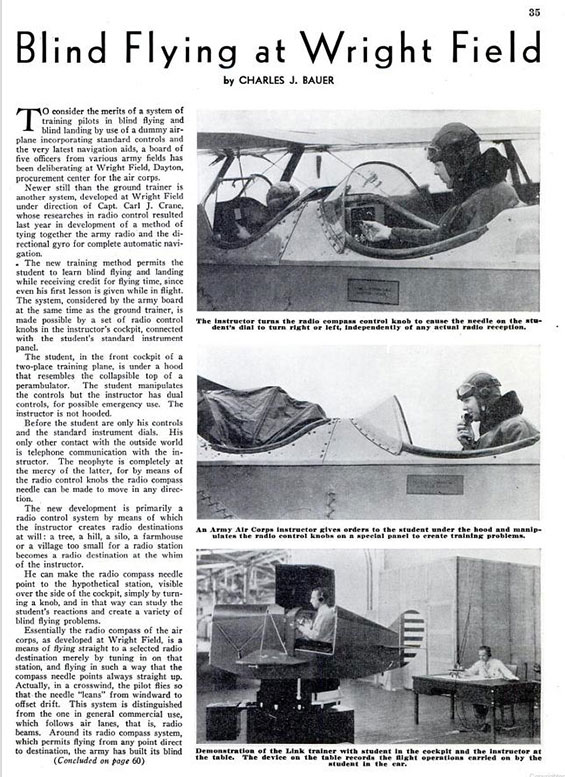 |
Second page follows.
Popular Aviation, July, 1937 (Source: PA)
 |
But, I digress. Several earlier references can be used to infer Crane's domiciles. The 1929 San Antonio city directory listed his residence as 1619 Highland Blvd. The 1930 Census, coded in April 16th, placed Crane at age 29 living at Brooks Field, TX in army quarters with his wife Nancy H. (23; 1905-1964) and their daughter Mary Barbara, age 2; 1928-2013). They had married in 1925 (see above).
A month later, Lt. Carl Crane landed once at Tucson, Sunday, May 18, 1930. Based at San Antonio, TX Brooks Field, he arrived at Tucson from San Diego, CA and identified his destination as San Antonio. He was solo in 28-32, a Boeing PW-9D. No purpose was cited for his flight through Tucson. Incidentally, about a year later, his airplane was assigned to the 43rd School Squadron and it crash-landed 14 miles northeast of Kelly Field, TX on Jul 27, 1931. It was written off as a total loss.
Below is an undated photograph of Crane courtesy of the San Diego Aerospace Museum Flickr Stream. Crane stands at left with an unidentified gentleman in coveralls. The airplane appears to be a military trainer.
Carl J. Crane (L), Date & Location Unknown (Source: SDAM)
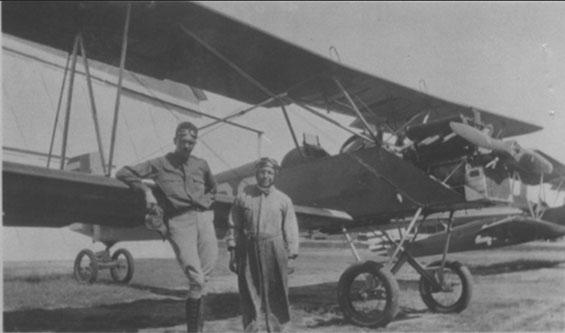 |
Below is a photograph of Crane (L) from August 1, 1939. The caption reads, "Captains Clarence S. Irvine and Pearl H. Robey, United States Army Air Corps, have used the Boeing Y1B-17 flying fortress (Model 299 F), serial number 37-369, to define a Fédération Aéronautique Internationale (FAI) World Record of altitude with a payload of 5000 kg. The Bomber climbed to 34,025 feet. On the same day, Irvine and Robey at the controls of the Y1B-17 from Dayton, Ohio set a world record speed with a payload of 5000 kg, at an average speed of 417.46 kilometres per hour (259.398 miles per hour)."
Captains Carl J. Crane, P. G. Miller, Clarence S. Irvine and Pearl H. Robey, August 1, 1939 (Source: Woodling)
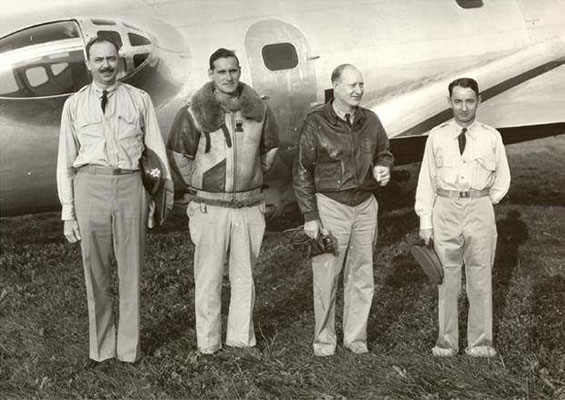 |
The 1940 Census identified his address as 1009 Grand Avenue, Dayton, OH. That neighborhood today is one of large, single-family homes of the type that would house Crane (age 40), his wife Nancy (40), daughters Barbara (12) and Nancy (3), and sons Carl, Jr. (8), Gregory (7), and John (5). They rented their home for $75 per month. His occupation was listed as "Major" in the "Army Air Corps." The Census stated that the family had lived at the same location at least since 1935. No mention was made of his daughter Mary identified as an infant in the 1930 Census.
Pamela H. Crane, Ninety-Nines Membership, 1969 (Source: 99s)
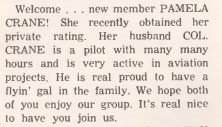 |
The city directories for Sacramento, CA, 1943 and 1949, placed Crane living at 1423 8th Avenue with Nancy. Nancy passed away November 18, 1964. Sometime between then and his death, Crane married Pamela Hoffman, whose name was engraved on his grave marker, below. I found records that Pamela was living in San Antonio in 1993, 2012 and 2014. I do not know if or when she passed.
Interestingly, Pamela Hoffman Crane was active in the San Antonio chapter of the Ninety-nines. She appeared in and contributed articles to the organization's newsletter over the years. Some are online, left. This brief, from February, 1969, identified her as a new pilot.
Carl J. Crane, Grave Marker, 1982 (Source: findagrave.com)
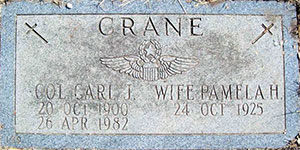 |
An extensive, 41-page oral history, recorded and transcribed April 28, 1981, was contained in Crane's biographical file at the Smithsonian (file number cited, top, left sidebar). This is an interesting read and worth acquiring from the NASM.
A year later Crane flew West from San Antonio on April 26, 1982 and was cremated there. His grave marker is at right. His death certificate is below. He died of a cerebral hemorrhage.
Carl J. Crane, Death Certificate, April 27, 1982 (Source: ancestry.com)
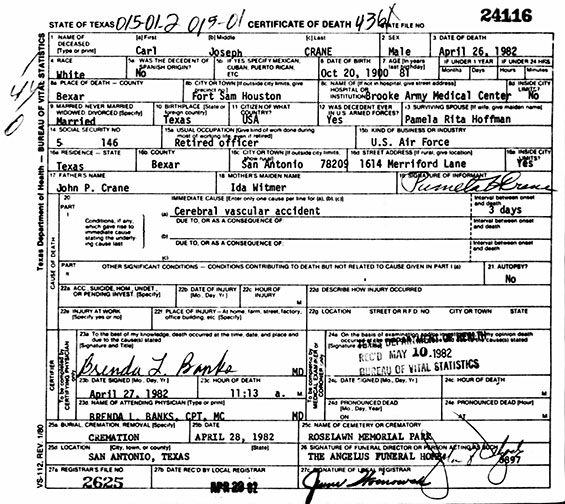 |
---o0o---
Dossier 2.2.61
THIS PAGE UPLOADED: 10/28/16 REVISED: 11/09/16
|










